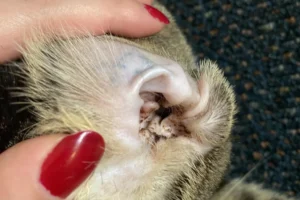Are you wondering why your cat’s ears are dirty? Let’s uncover the reasons behind this common issue.
It’s important to understand why your cat’s ears may appear dirty in order to properly care for them. Let’s explore the potential causes and solutions to this common concern.
Natural Buildup of Wax
When it comes to cats’ ears, a natural buildup of wax can often be the culprit behind their dirty appearance. Just like humans, cats produce ear wax to protect and lubricate their ear canals. However, if this wax is not regularly cleaned out, it can accumulate and mix with dirt and debris, leading to dark, waxy buildups in their ears.
To prevent this natural buildup from making your cat’s ears look unkempt, it’s essential to regularly inspect and clean their ears. Gently wipe the outer part of the ear with a soft cloth or cotton ball dampened with ear cleaner recommended by your veterinarian. Avoid inserting anything into your cat’s ear canal to prevent injuries or irritation.
Top Tips for Cleaning Your Cat’s Ears:
- Use a gentle ear cleaner recommended by your veterinarian.
- Avoid inserting anything into the ear canal.
- Clean the outer part of the ear with a soft cloth or cotton ball.
Ear Mites
Ear mites are another common cause of dirty-looking ears in cats. These tiny parasites can infest your cat’s ears, causing irritation, discomfort, and a buildup of dark debris. Ear mites are highly contagious among cats and can easily spread from one cat to another.
If you suspect that ear mites are the reason behind your cat’s dirty ears, it’s crucial to consult your veterinarian for proper diagnosis and treatment. Your vet may prescribe medication to eliminate the ear mites and soothe your cat’s ears.
Remember, keeping your cat’s ears clean and healthy is essential for their overall well-being. By regularly cleaning their ears and monitoring for ear mites, you can help ensure that your feline friend stays happy and comfortable.
Infections
Dirty cat ears can often be a sign of an underlying infection. Ear infections in cats can be caused by a variety of factors, including bacteria, yeast, or mites. If your feline friend is constantly scratching at their ears, shaking their head, or displaying redness and swelling, it’s time for a trip to the vet.
To address ear infections, your vet may prescribe medication, such as antibiotics or antifungal drops, to target the specific cause of the infection. Proper cleaning of your cat’s ears may also be necessary to remove buildup and debris contributing to the infection. Remember, never use cotton swabs to clean your cat’s ears as this can push debris further into the ear canal and potentially cause harm.
Proper diagnosis and treatment of ear infections are crucial to prevent further complications and keep your cat’s ears healthy and clean.
Allergies
Allergies can also play a role in causing dirtiness in a cat’s ears. Just like humans, cats can be allergic to various environmental factors like pollen, dust, or certain foods. When a cat is exposed to an allergen, it can trigger an inflammatory response that may lead to itching, redness, and excess wax production in the ears.
To manage allergies effectively, it’s important to identify the specific allergen causing the reaction. Your vet may recommend allergy testing to pinpoint the allergen and suggest strategies to minimize your cat’s exposure to it. In some cases, medication like antihistamines or allergy shots may be prescribed to alleviate symptoms.
Regular ear cleaning can also help reduce the buildup of allergens in your cat’s ears, preventing infections and keeping them clean and healthy.
Additional Unique Insight:
One often overlooked factor in keeping cat ears clean is their diet. A high-quality, balanced diet can help boost your cat’s immune system, making them less susceptible to infections and allergies that can lead to dirty ears. Consider speaking to your vet about the best diet for your furry friend to support overall ear health.
Excessive Grooming
Excessive grooming can often lead to dirty ears in cats. When cats groom themselves excessively, they can transfer dirt and debris from their paws or body into their ears, causing a buildup that can be difficult to clean. To prevent this behavior, provide your cat with regular grooming sessions to keep their coat clean and reduce the need for excessive grooming. Additionally, offer interactive toys or puzzle feeders to keep your cat mentally stimulated and reduce stress that may trigger excessive grooming habits.
Breeds Prone to Dirty Ears
Some cat breeds are more prone to having dirty ears due to factors like ear shape or coat length. Persian cats, with their luxurious long fur, are more likely to have dirty ears, as the hair can easily trap dirt and debris. Scottish Fold cats, known for their folded ears, may also experience more earwax buildup. Owners of these breeds should regularly check and clean their cats’ ears to prevent infections or other issues. Use a damp cloth or specialized ear cleaning solution to gently wipe away any dirt or wax buildup. Regular ear checks can help catch any problems early before they escalate.
Breeds Prone to Dirty Ears:
- Persian: With their long fur, these cats are more prone to dirty ears.
- Scottish Fold: Their unique ear shape can lead to more earwax buildup.
By being proactive and attentive to your cat’s grooming needs, you can help prevent dirty ears and ensure your feline friend stays healthy and happy.
Regular Ear Cleaning
Dirty ears in cats can be caused by a buildup of wax, dirt, or even ear mites. To prevent this, regular ear cleaning is essential. Simply use a gentle ear cleaner designed for cats and a soft cotton ball or pad. Gently wipe the outer parts of your cat’s ears, avoiding going too deep into the ear canal. Cleaning your cat’s ears regularly can help prevent infections and discomfort.
Here are some tips for safely and effectively cleaning your cat’s ears: 1. Stay calm and gentle: Approach your cat calmly and be gentle when handling their ears to ensure a stress-free experience. 2. Use the right tools: Choose a cat-specific ear cleaner and soft cotton pads to avoid any irritation. 3. Check for signs of infection: If you notice redness, swelling, or a foul odor, consult a vet before cleaning.
Seeking Veterinary Care
If you notice persistent dirtiness in your cat’s ears despite regular cleaning, it’s crucial to seek veterinary care. It could indicate an underlying issue such as an infection or ear mites. Do not delay in seeking professional help to ensure your cat’s ear health.
When to seek veterinary care:
– Persistent dirtiness: If regular cleaning doesn’t resolve the issue, consult a vet.
– Unusual behavior: Scratching ears excessively, head shaking, or tilting could indicate a problem.
– Foul odor or discharge: Any unusual smells or discharge from the ears require immediate attention.
– Pain or discomfort: If your cat shows signs of pain when you touch their ears, it’s time to visit the vet.
Remember, your cat’s ears are vital for their well-being, so prompt veterinary care is crucial for maintaining their health.
Interesting Facts About Cat Ears
Did you know that cats have around 32 muscles in each ear? This allows them to rotate their ears up to 180 degrees to pinpoint the source of a sound. Another fascinating fact is that a cat’s ear shapes are unique, like a fingerprint, making each cat’s ears distinctive. Additionally, cats use their ears not only for hearing but also for communication. Pay attention to the position of your cat’s ears to understand their mood better.
Why Are Cats Ears Dirty?
Cats are meticulous groomers, often licking themselves clean, but their ears can still get dirty due to the buildup of wax and debris. Dirt in a cat’s ears can also be a sign of ear mites, infections, or allergies. Regularly check your cat’s ears for cleanliness and any signs of irritation. If you notice excessive dirt or a foul odor, consult your veterinarian for proper cleaning and treatment.
Quick Tips for Cleaning Cat Ears:
- Use a vet-approved ear cleaning solution: Never use cotton swabs, as they can push debris deeper into the ear canal.
- Gently wipe the visible part of the ear: Use a soft cloth or cotton ball dampened with the cleaning solution.
- Monitor your cat’s ear health regularly: Look for signs of swelling, redness, or unusual discharge.
- Seek veterinary advice if needed: If your cat shows signs of discomfort or persistent ear issues, consult a professional for proper diagnosis and treatment.
Alex, a passionate animal lover, has experience in training and understanding animal behavior. As a proud pet parent to two dogs and three cats, he founded AnimalReport.net to share insights from animal experts and expand his knowledge of the animal kingdom.




